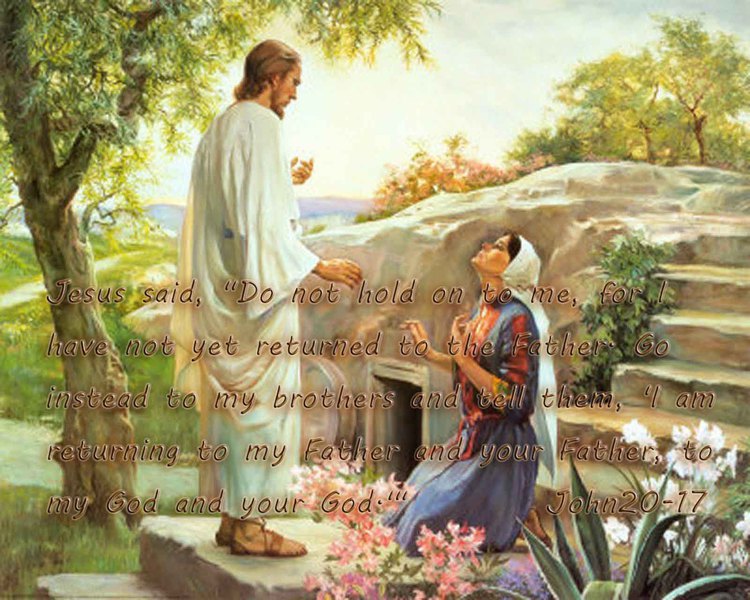Reflection on John 20:1-18
Karen-102804 04/13 8850
4.0/1

All four Gospels give eyewitness accounts of those who saw the risen Lord. For more than two thousand years, Christians have joyfully proclaimed the resurrection of Jesus Christ to be "good news". The resurrection of Jesus Christ stands alone at the center of the Christian faith. John 20 simply narrates the plain events surrounding Jesus' resurrection.
The day after Jesus' crucifixion was the "special Sabbath". However special that day was, the Bible does not mention anything happened on that day. It leaves us a lot of room to envision what was going on in the minds of Jesus' friends. I am almost sure none of them thought that Jesus might rise bodily from the dead. This thought never entered the minds of the women who observed Jesus' burial since they "bought spices so that they might go to anoint Jesus' body." If they ever expected Jesus' resurrection, they wouldn't never buy those expensive spices. They might spend the whole day discussing "who will roll the stone away from the entrance of the tomb" for them as Mark tells us.
It's likely that Mary Magdalene and a few other women didn't have a good sleep in the special Sabbath night. "Early on the first day of the week, while it was still dark, Mary Magdalene went to the tomb" along with other women" and saw that the stone had been removed from the entrance." The women were shocked when an angel tried to calm them, while "there was a violent earthquake at the time. The angel said, "Do not be afraid, for I know that you are looking for Jesus, who was crucified. He is not here; he has risen, just as he said." Mary probably didn't hear or understand what the angel just said, or more likely she didn't wait until the angel appeared to them. As soon as she saw the stone had been removed, without going into the tomb, she already made conclusion that someone took the body. She immediately ran to tell "Simon Peter and the other disciple, the one Jesus loved, and said, 'They have taken the Lord out of the tomb, and we don't know where they have put him!'" The tone in her words was so agitated that the beloved disciple John had to use a exclamation mark at the end of her sentence. Little did she know how wrong she was! Anyway, at that time, most of the men dismissed women's report as nonsense. By Jewish law, women were not qualified as witnesses.
The disciples were already perplexed and despondent by Jesus' crucifixion. Until a few days before, they still expected that Jesus as the Messiah would overcome all opposition! Now they seemed to feel cruelly disillusioned and even ashamed. Perhaps someone had already accused them of following a false prophet. They were still convinced of Jesus' absolute holiness. Yet this left them more confused. And they figured that no one wanted to do anything with a dead body which was in tomb already and had no valuables buried with it. If Jesus' body was gone, it just meant more trouble for them. "So Peter and the other disciple started for the tomb. " The other disciple was John himself. In writing his Gospel, John never referred to himself by name. He "outran Peter and reached the tomb first. He paused and bent over and looked in at the strips of linen lying there but did not go in." Perhaps his emotion was too great or he was shocked by the astonishing sight he saw. As John was stood deep in thought, Simon Peter who was behind him arrived, pushed past him "and went into the tomb. He saw the strips of linen lying there, as well as the burial cloth that had been around Jesus' head. The cloth was folded up by itself, separate from the linen." John didn't tell us what Peter made out of the scene. But he tells us, after he finally went inside the tomb, "he saw and believed." Had either enemies or friends taken the body, they would never have removed the linen and carried a naked, bruised body. And the cloth that had been wrapped around Jesus' head lay separate from the other cloths. It still retained its fold. It was as though the body had simply passed through the fabric. As John put the scene together, he began to recall how Jesus had foretold His resurrection. The truth then flooded his mind. This is John's testimony of how he came to believe in Jesus' resurrection. Years later, when he penned down this part of his Gospel, he confessed with a degree of shame that at that point he had not connected the prophecies of Old Testament with Jesus' resurrection. He made a point of saying, "They still did not understand from Scripture that Jesus had to rise from the dead." This admission underscores the fact none of the disciples had expected Jesus' resurrection.
Although John doesn't tell us if Peter believed or not, I personally think Peter also believed in Jesus' resurrection at that point because after Peter and John examined the tomb, they simply left. They didn't stay to search for Jesus' body as Mary Magdalene did. If Peter didn't believe the resurrection, he would have stayed to search for the body.
As we compare the Gospel accounts, it seems Mary Magdalene first ran back to tell Peter and John of the open and empty tomb and then immediately returned to the scene. Meanwhile, the other women had left. "Mary stood outside the tomb crying" since she didn't believe Jesus' resurrection yet. She wanted to find the body. "As she wept, she went over to look into the tomb and saw two angels in white, seated where Jesus' body had been, one at the head and the other at the foot." The angels gently asked her, "Woman, why are you crying?" The angels were reminding her that she shouldn't cry after what she saw. But Mary Magdalene didn't get it from what she saw. She said to the angels, "They have taken my Lord away, and I don't know where they have put him." Her mind was still on the dead body. She loved her Lord so much that she intended to find His dead body so she could take good care of it. Perhaps at that moment, she caught the angels' glance as they looked over her shoulder, "she turned around and saw Jesus standing there, but she did not realize that it was Jesus." Was it tears, grief or unbelief that blinded her? Jesus first asked her the same question as the angels did, then adding, "Who is it you are looking for?" Mary Magdalene assumed the One who talked to her was the gardener, she begged, "Sir, if you have carried him away, tell me where you have put him, and I will get him." I don't know how strong Mary Magdalene was. Was she sure that she could handle the dead body by herself? One thing I can feel. I can feel her love and deep affection for her Lord even when she thought He remained as dead.
In response, Jesus simply stated her name, "Mary." It was enough. As the Lord Jesus called Mary by her name, she immediately knew her Shepherd's voice. "She turned toward Him and cried out in one word, 'Rabboni' which means Teacher." Then Jesus said to her, "Do not hold on to me, for I have not yet returned to the Father." Later, Jesus invited His disciples to touch His body and did not rebuke those who did. But Jesus knew that Mary had only knew Him in His human form. In her great joy, she tried to hold on to Him, unwilling to let go. Mary had not yet realized a new relationship was to begin, one of faith instead of merely sight and touch. After His ascension, the Lord would bless Mary with a far closer relationship through the Holy Spirit. There would be no problem for Mary to "hold on" or "cling to" the Holy Spirit. She was welcomed to do so. Then Mary would enter into a new, closest, permanent communion with Christ, her Lord. Mary was privileged to be among the first to see, talk to and touch the risen Lord. But such a privilege always carries responsibility. Jesus immediately gave Mary a task, "Go instead to my brothers and tell them, 'I am returning to my Father and your Father, to my God and your God." By claiming that Mary and Himself having the same "Father", the same "God", Jesus confirmed that Mary belonged to His family. And Mary was commanded to tell of His resurrection and ascension to "His brothers" who were also His and her family members. The privilege and command that Jesus gave to Mary, He gives to every believer. Mary took her privilege joyfully and her command seriously. She returned to the disciples with the good news, "I have seen the Lord!" And she told them what Jesus had said to her. Has He ever wiped away your tears and given you joy so you can have a similar, genuine, personal testimony, "I have seen by faith the Lord!" Then your task is the same! Tell others about Him and what He has done for you!


